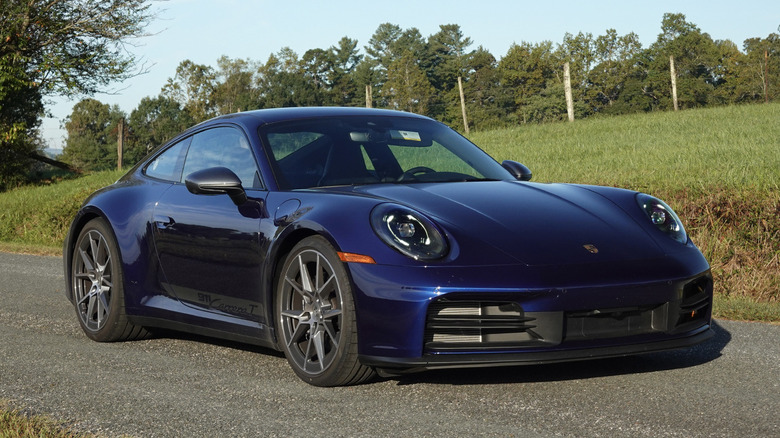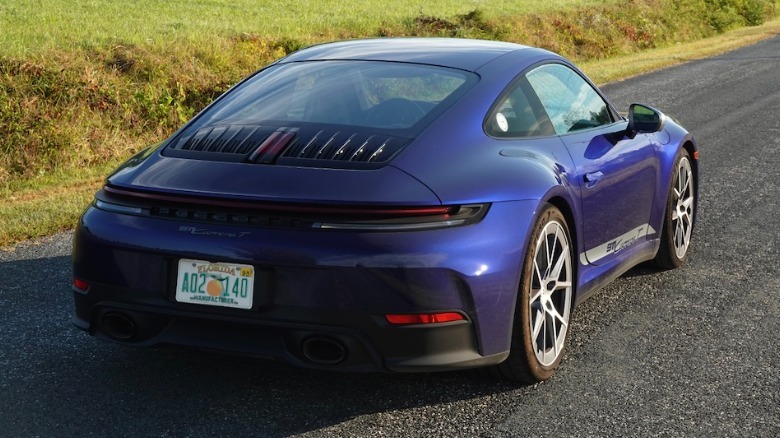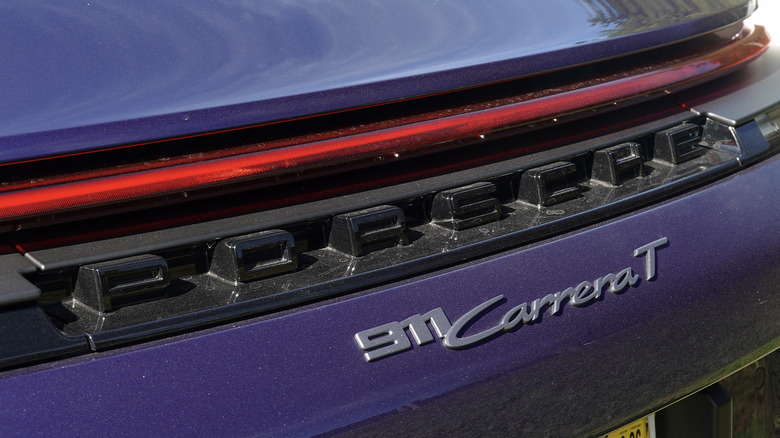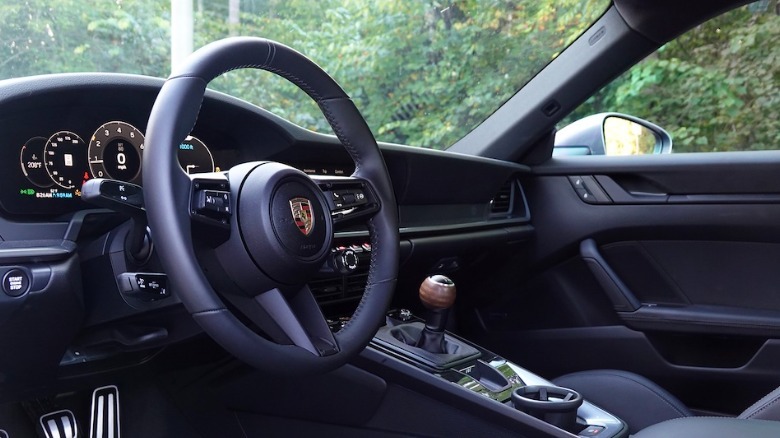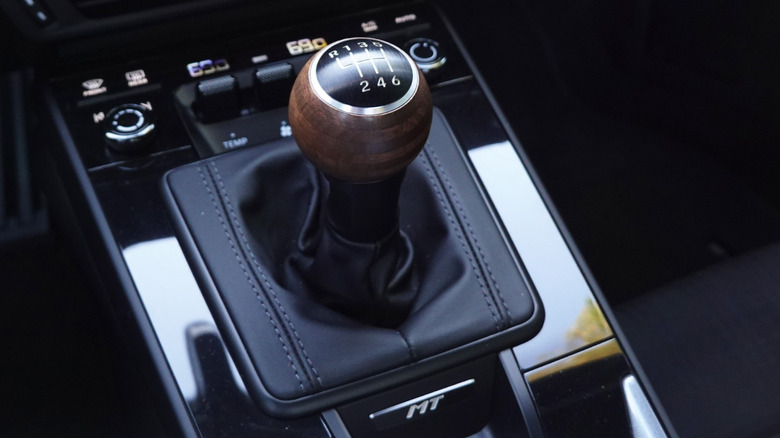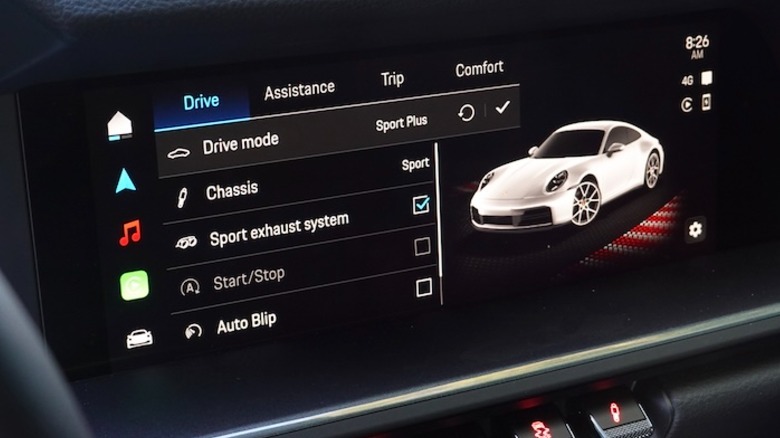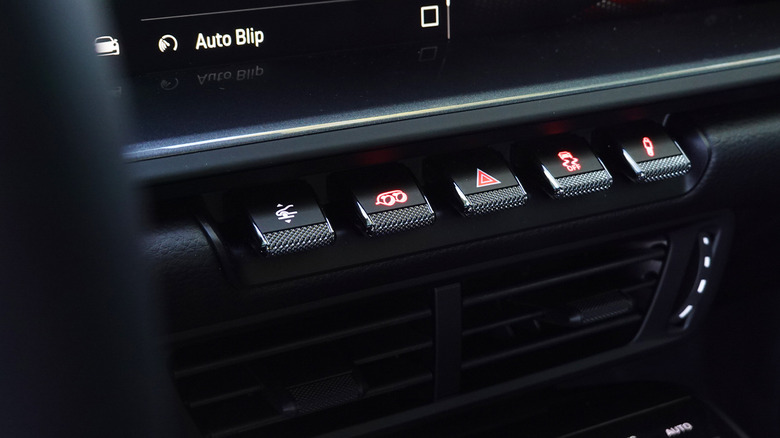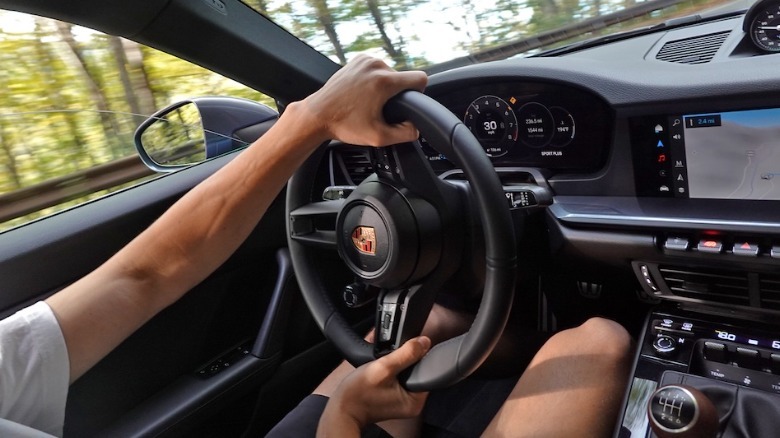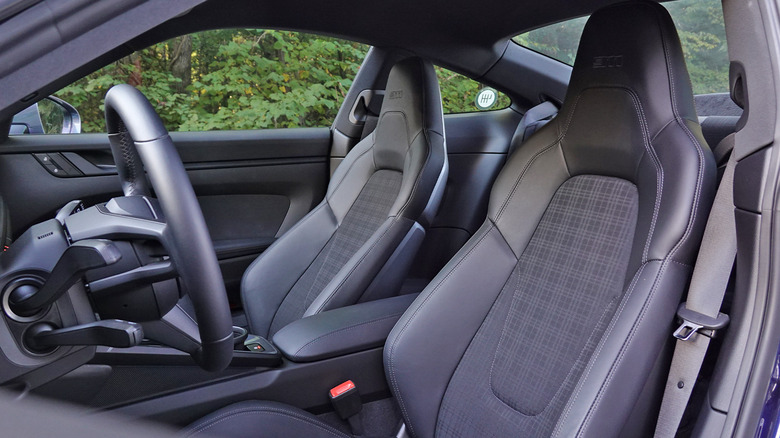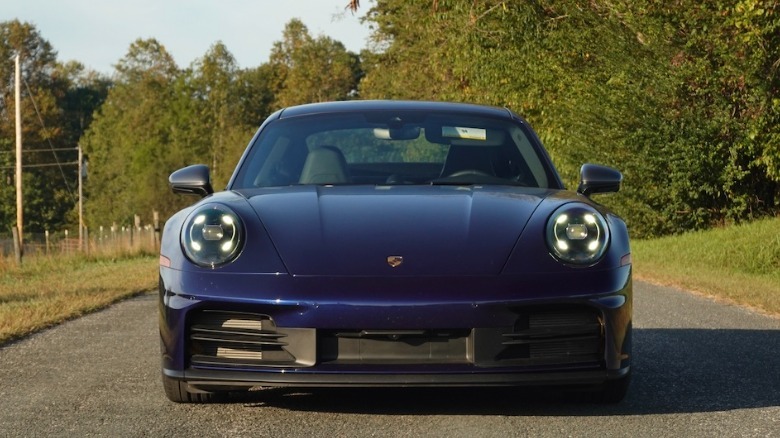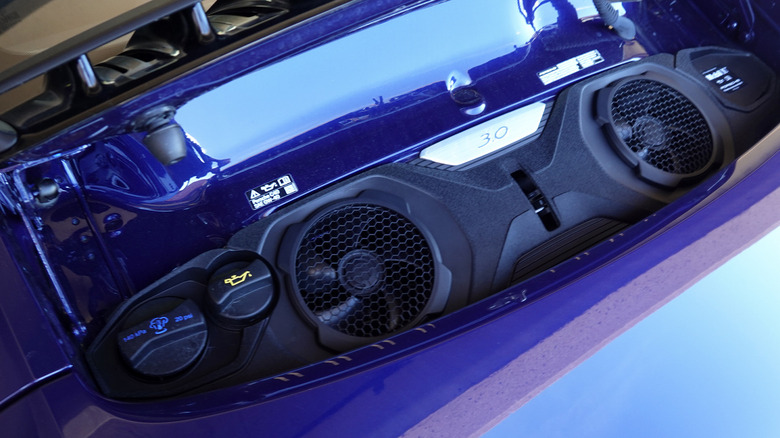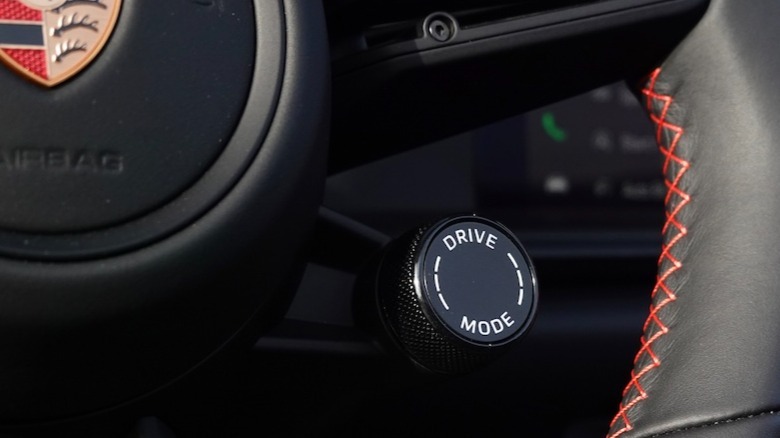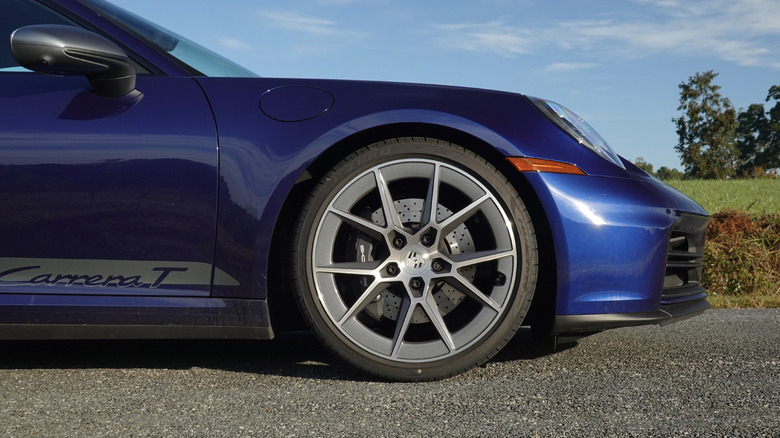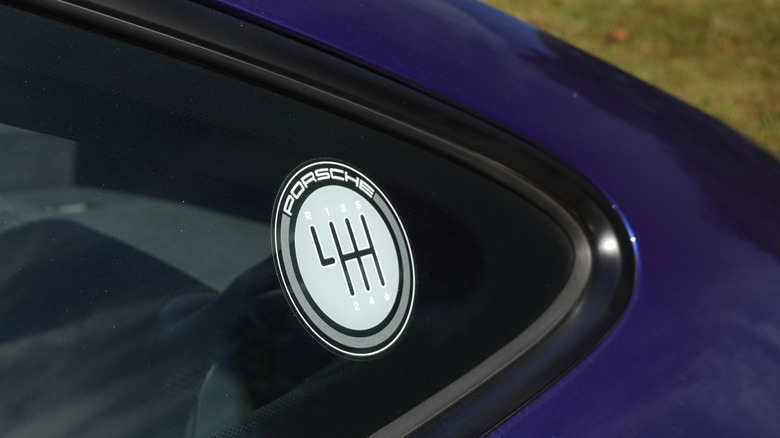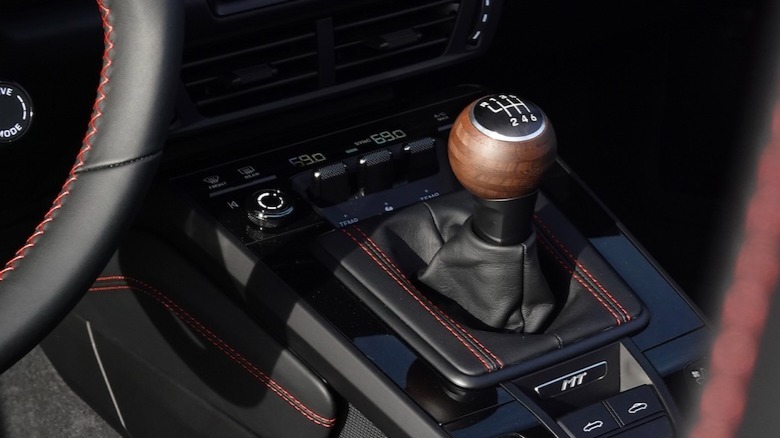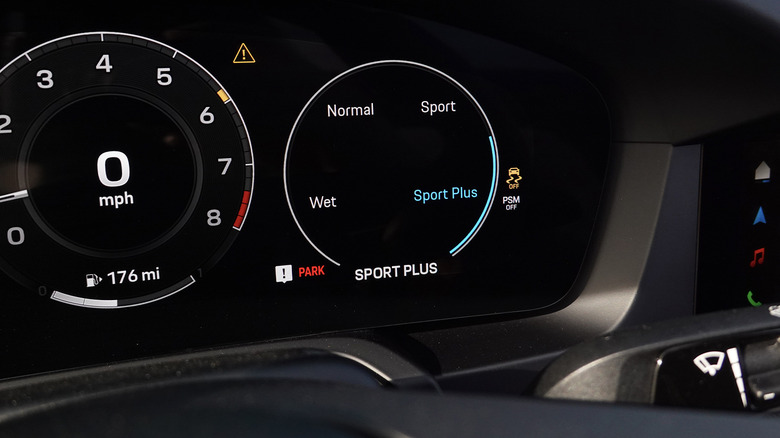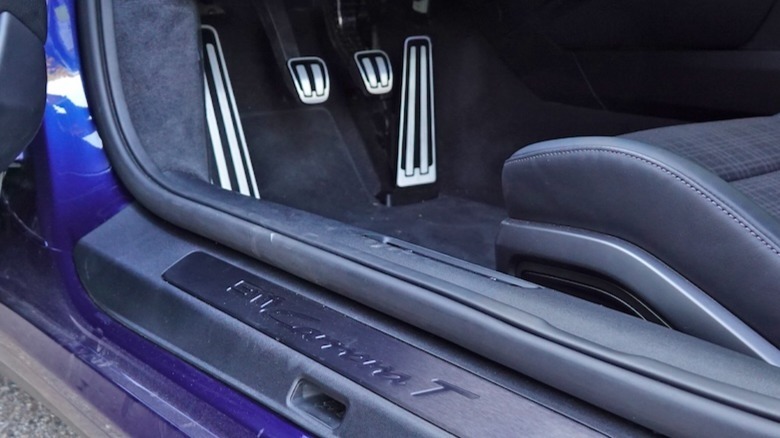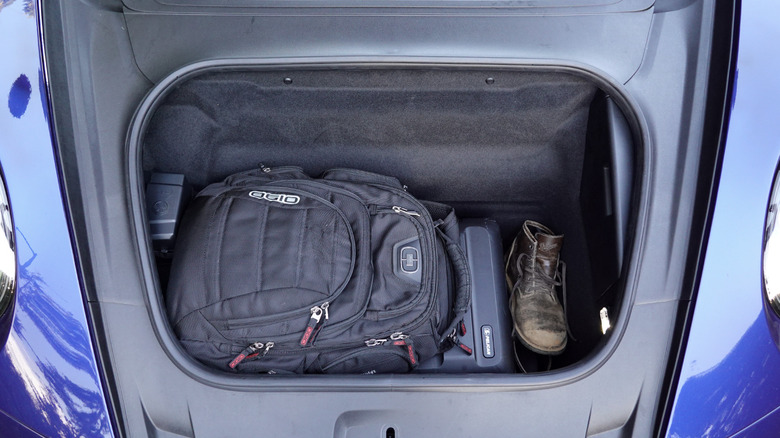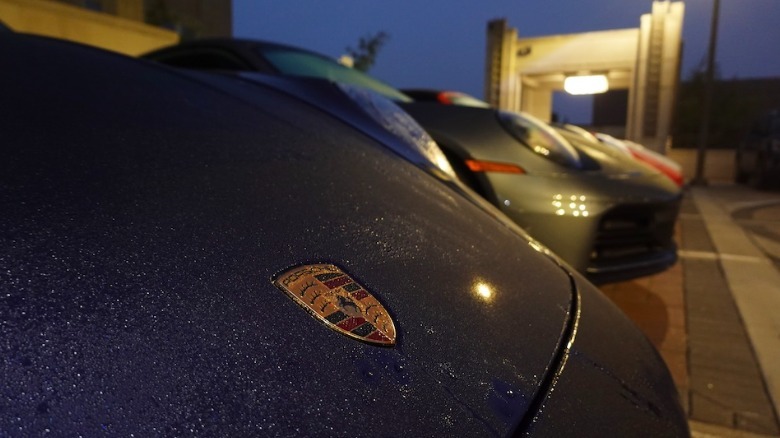This Is The Best New 911 (And Maybe The Best New Porsche, Period)
Not much in life beats putting a ton of miles and dirt on a stick-shift Porsche 911. Especially the newest 992.2-generation Carrera T, which aims to satisfy driving enthusiasts with a select set of options and option deletes that broaden the quintessential all-rounder sports car's all-around appeal. I spent a week with a Carrera T Cabriolet earlier this year, and even though I typically prefer coupes, the T's sublime suspension, perfect powertrain, and comfort level still stood out as incredibly impressive.
The coupe looks better, though, and hews more closely to the true T ethos. The rear end's engine decklid no longer needs to bulge upward to house a convertible top, the T's lightweight glass and sound deadening help to further reduce weight, and the roof even comes in "slicktop" form (which in Porsche parlance means no moon- or sunroof). In short, the Carrera T coupe best epitomizes "less is more" in Porsche's current 911 lineup, as I more recently learned over the course of a two-day road trip from the Porsche Experience Center in Atlanta, Georgia, to the Luftgekühlt 11 show in Durham, North Carolina.
All the letters of the alphabet
Porsche revived the T for the new millennium by pointing back at the original entry-level T that debuted in 1967 as the cheapest 911 in the lineup, with a less powerful engine, a simplified interior, and even steel wheels. But if that recipe sounds less relevant in comparison to today's T, the more accurate alphanumerical comp from Porsche's long history is really the 911L, something of a stand-in that combined the base 911 engine with all the S model's performance and luxury features.
For the 992.2-gen T, the base Carrera's twin-turbocharged 3.0-liter flat-six combines with a similar selection of options—and a lack thereof—that previously appeared on the 991.1 T. The T ticks a few fancy boxes, including the Sport Chrono package and a host of shift pattern stickers thrown on everywhere to serve as a reminder of the manual transaxle that engine bolts up to. At least this specific example skipped the hilariously unnecessary puddle lights as a sixth and seventh stick-shift callout.
Not a GT3, but shares GT3 parts
And please try not to focus on the fact that a T coupe represents the only way to enjoy a manual 911 without stepping up to GT3 money. That might sound criminal, but amid the stark reality of a modern era rife with overpowered and unrefined bruisers, this car's power-to-weight ratio almost perfectly toes the line between rational and thrilling. For your consideration: 388 horsepower and 331 lb-ft of torque in a car that can weigh as low as 3,283 pounds, with a rear-mounted engine bracketed in place by peak German engineering, good for a 4.3-second sprint to sixty with only one punch of the clutch pedal to get up into second gear. Do I truly need to drive any quicker?
Leaving the ATL on less than ideal freeway surfaces, I noticed just how much less the coupe's sound deadening drowns out tire hum and wind noise than the Cabriolet, which tries to combat the soft top's potential racket by deleting, in turn, the coupe's sound deadening delete. But the slightly-less-insulated coupe therefore unlocks a new soundtrack from the engine bay directly behind two vestigial rear seats, as more turbo spooling whine filters through at lower revs alongside a slightly more grumbly exhaust. A worthy tradeoff? Maybe... But Porsche also routes a hint of exhaust into the cabin, I learned, without sacrificing the raspy nature of previous naturally aspirated flat-sixes.
Finding the best roads
Curiously, Porsche also deleted the 992.1's seventh gear ratio, controlled via a new open-pore walnut shifter and GT3-sourced linkages. Yet the newly top sixth still never seems too short for highway driving. Keep the exhaust valving closed and the dampers in the softer of two settings, short shift the 10-millimeter shorter shifter, and cruise at low RPMs to make those long straight freeway sections fly by in calm comfort. Luckily, our two-day trip included minimal time on the straight and flat roads before northern Georgia's low hills started to sprout up, though for various reasons we also skipped over the most famous—and infamously crowded—routes like Tail of the Dragon or Cherohala Skyway.
Instead, between stints of pastoral countryside, our circuitous path into North Carolina included more than a healthy dose of half-hour or so flow state stints thoroughly in the Carrera T's happy place. Somehow, the weather and traffic in this portion of the nation seems not to tear up asphalt too terribly, resulting in a solid combination of smooth pavement—but not too smooth—as the terrain transitions from wide sweepers at lower elevations to low second or high first-gear corners nearly at redline.
Suspension matters so much more these days
I spent these hard-charging moments appreciating the T's perfectly judged suspension most, and actually found the combination of Sport drive mode with the suspension still in the softer damping slightly more communicative, reducing road chatter and keeping the body more planted despite any small bumps or larger heaving undulations. The coupe, specifically, rides with a different character than the Cab, as the stiffer chassis and reduced weight (189 pounds lighter, to be specific, when otherwise similarly optioned) force the Sport PASM dampers to work slightly more. Bump steer becomes almost nonexistent despite the larger S wheels, a staggered set of 20- and 21-inchers front and rear respectively.
As another plus, the coupe's larger greenhouse allows for vastly superior visibility, still a quintessential 911 trait despite the 992 generation's enlarged footprint and higher waistline. So I spent my time leaping ahead on straightaways, braking at the edge of ABS, and carving corners in ecstasy all while easily keeping an eye on any potential chasers in my rearview. Even if some of the tightest stretches, where streams etch narrow canyons into the hills, probably dictated a downshift to first, I spent more time in second, letting the revs fall and then reveling in the rush of turbocharged acceleration as boost built into higher RPMs.
Lightweight in a heavyweight era
The T coupe thrives here in a Goldilocks zone, upshifting to third and then back down to second, braking with a bit of muscle as the larger six-piston front calipers haul down speed, heel-toeing with auto blip off, and feathering in steering with only my fingertips. The Pirelli P Zero tires only oiled up a bit on a warm afternoon, which then allowed for a bit more fun fiddling with Porsche Stability Management and traction control. After all, why not steer more with my right foot, forcing the rear diff to put in some work? The miracle of modern engineering never led to any snappy tail wagging that occasionally made older 911s a handful. Instead, judicious applications of throttle with the wheel still cranked over brought on the gentlest and most predictable oversteer possible.
More power always sounds more better but, after driving the new 911S and the GTS too, that adage fades in the face of simplifying and adding lightness. Hitting that 3,316-pound minimum weight without the uncomfortable carbon bucket seats (on the way out in favor of a newly redesigned set—available soon) also helps to hit a key price point. As tested, this Carrera T stickers just shy of $150,000 over a $138,800 starting price tag, not bad for the average Porsche these days. I definitely want the extended range fuel tank, only a $230 add, but also believe in the freedom of front-axle lift, which tacks on another $3,090.
Imagining an even further simplified 911
Otherwise, a large part of me might argue for even more decontenting. Skipping Sport Chrono, in particular, might save a hefty chunk. And after going deep on the T Cab's rear-steer, now mandatory to sharpen the front steering ratio, I still vote against making the system standard as opposed to optional on the previous 991.1 T. And not just to save some cash, but also because of the occasionally off-putting sensation that rear-steer can cause, most typically while about two-thirds of the way through a long sweeper when the rear tires suddenly start to sway a bit, forcing an unexpected last-second input into the fronts, too.
I certainly want the base seats, as nice as the plaid inserts look on this car, because counterintuitively the cheapest thrones also come with ventilation—the only rational reason to buy any new car, in my humblest of opinions. On the other hand, I prefer the matte carbon dash versus the faux leather plastic on my coupe, even if ticking that box admittedly runs somewhat anathema to the entire T ethos.
Coupe vs Cab, the eternal debate
At the very least, I appreciate that Porsche still even allows configuration with specific options, rather than strictly packages—even if the base packages to build upon now make less sense than ever. My dream T coupe skips the graphics and badging, in a dark grey metallic to help the piano black exterior plastics fade away, with a black leather and carbon-trimmed interior. Yet I also cannot then select a rear wiper, disallowed by the lightweight glass. And another modern miracle of automotive engineering, adaptive cruise control, also cannot come with a manual.
My old coupe versus convertible proclivities once again confirmed, I handed the keys back at Luftgekühlt. Even with some of the greatest Porsches on the entire planet surrounding me, I struggled to imagine that any of the show cars can even come close to scratching the same myriad of itches as a 992.2 Carrera T coupe. Is this truly the perfect sports car? Well, the only thing I can remember coming anywhere near to a similar vicinity of all-around capability that so recently went out of production: none other than Porsche's best car of the current era, the 718 Cayman GTS 4.0 of course.
Lessons learned from the GTS 4.0
The end of the line for the GTS 4.0 probably stretched out a few years longer than originally intended amid the inevitable delays to an EV successor. I believe the GTS 4.0 therefore survived long enough to witness the new T serve as something of a spiritual successor in newfound 911 form, a sports car that perfectly marries slightly softer suspension with just the right amount of power and precision to create a sense of working with the car rather than suffering through the process of finding pace.
Sure, a naturally aspirated flat-six pumping out 394 horsepower in a car that weighs a little less, at 3,175 pounds, naturally helps. And the exhaust bark up near 8,000 RPM, a necessary realm of the tach where all that grunt unlocks given the lack of turbos, surely contributes to my Cayman love affair (not to mention the convenience of two trunks rather than two tiny backseats, even if the rear warms up quickly). But more importantly, the GTS 4.0's chassis tuning versus the GT4—and perhaps even the lifted 911 Dakar—taught Porsche a few lessons about amplifying driver inputs in the midst of increasingly digitized engineering, rather than simply stiffening up everything in the name of lap time supremacy.
2025 Porsche 911 Carrera T Coupe verdict
The T's #savethemanuals theme certainly fit in well while wandering around Luftgekühlt 11, which celebrated 20 years of the 911's 993 generation. The packed venue showed how much even non-purists still appreciate that analog driving era—and data shows exactly how much collectors do, too. Hagerty's Automotive Intelligence team reported to me that a 993-gen 911 with the Tiptronic automatic now commands about 15% less on the market than a manual. Doing the math, a base 992.2 Carrera starts at $122,095 and adding 15% jumps almost exactly to the price for a T. Coincidence? I think not...
Where other manual makes and models on the market, notably the Toyota Supra and BMW Z4, might survive on stick shift take rates alone, Porsche faces a different quandary. That 718 replacement now looks likely to offer both a full EV and a hybrid powertrain, but if the hybrid shares everything with the GTS-T's setup, that means PDK only. Which also means that soon enough, the Carrera T might well occupy the enviable position as the single cheapest Porsche available new with a stick shift. Cause for concern, yes, but as well as this car drives, cause for serious celebration too.
